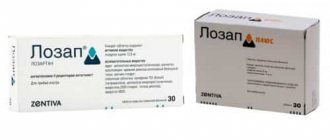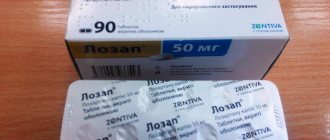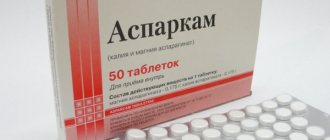Rosulip®
| Mode | Mode | Change |
| accompanying | reception | A11C |
| therapy | rosuvastatin | rosuvastatin |
| Cyclosporine | 10 mg 1 time per | Increase in |
| 75-200 mg 2 | day, 10 days | 7.1 times |
| times a day, 6 | ||
| months | ||
| Atazanavir 300 | 10 mg | Increase in |
| mg/ritoiavir | once | 3.1 times |
| 100 mg 1 time per | ||
| day, 8 days | ||
| Lopinavir 400 | 20 mg 1 time per | Increase in |
| mg/ritoiavir | day, 7 days | 2.1 times |
| 100 mg 2 times a day | ||
| days, 17 days | ||
| Gemfibrozil | 80 mg | Increase in |
| 600 mg 2 times a day | once | 1.9 times |
| day, 7 days | ||
| Eltrombopag | 10 mg | Increase in |
| 75 mg once a day | once | 1.6 times |
| day, 10 days | ||
| Darunavir 600 mg/ritonavir 100 mg 2 times a day, 7 days | 10 mg 1 time per day, 7 days | 1.5 times magnification |
| Tipranavir 500 mg/ritonavir 200 mg 2 times a day.. 11 days | 10 mg once | 1.4x magnification |
| Dropedarone 400 mg 2 times a day. | No data | 1.4x magnification |
| Itraconazole 200 mg once a day, 5 days | 10 mg or 80 mg once | 1.4x magnification |
| Ezetimibe 10 mg once a day, 14 days | 10 mg 1 time per day, 14 days | 1.2 times magnification |
| Fosamprenavir 700 mg/ritonavir 100 mg 2 times a day, 8 days | 10 mg once | Without changes |
| Aleglitazar 0.3 mg, 7 days | 40 mg, 7 days | Vez changes |
| Silymarin 140 mg 3 times a day, 5 days | 10 mg once | Without changes |
| Fenofibrate 67 mg 3 times a day, 7 days | 10 mg, 7 days | Without changes |
| Rifampin 450 mg once a day, 7 days | 20 mg once | Without changes |
| Ketoconazole 200 mg 2 times a day, 7 days | 80 mg once | Without changes |
| Fluconazole 200 mg once a day, 11 days | 80 mg once | Without changes |
| Erythromycin 500 mg 4 times a day, 7 days | 80 mg once | 28% reduction |
| Baikalin 50 mg 3 times a day, 14 days | 20 mg once | 47% reduction |
The effect of rosuvastatin on other drugs
Vitamin K antagonists: Initiate rosuvastatin therapy or increase the dose of the drug in patients receiving concomitant vitamin K antagonists (eg, warfarin). may lead to an increase in the International Normalized Ratio (INR). Discontinuation of rosuvastatin or reduction of the drug dose may lead to a decrease in INR. In such cases, INR monitoring is recommended.
Oral contraceptives/hormone replacement therapy: Concomitant use of rosuvastatin and oral contraceptives increases the AUC of ethinyl estradiol and AUC of norgestrel by 26% and 34%, respectively. This increase in plasma concentration should be taken into account when selecting the dose of oral contraceptives.
There are no pharmacokinetic data on the simultaneous use of Rozulip® and hormone replacement therapy; therefore, a similar effect cannot be excluded when using this combination. However, this combination was widely used during clinical trials and was well tolerated by patients.
Other medicinal products: No clinically significant interaction between rosuvastatin and digoxin is expected.
Instructions for use ROSULIP®
Effect on kidney function
Proteinuria has been observed in some patients taking high doses of rosuvastatin (especially the 40 mg dose). Proteinuria was diagnosed by urine test using test strips. In most cases, it was of tubular origin and was transient or intermittent. Proteinuria did not necessarily indicate the development of acute or progressive renal failure. In the post-registration period, serious renal dysfunction was more often observed in patients taking rosuvastatin at a dose of 40 mg. As part of the standard examination of patients receiving Rozulip® at a dose of 40 mg, it is necessary to periodically monitor renal function.
Effect on skeletal muscles
Side effects from skeletal muscles (for example, myalgia, myopathy, and, in rare cases, rhabdomyolysis) were observed in patients taking the drug at any dose, most often at doses exceeding 20 mg. Very rarely, rhabdomyolysis developed during concomitant therapy with ezetimibe and HMG-CoA reductase inhibitors. Since pharmacodynamic interactions cannot be excluded (see Drug Interactions), caution should be exercised when using these drugs simultaneously. As in the case of therapy with other HMG-CoA reductase inhibitors, rhabdomyolysis developed more often when using the drug at a dose of 40 mg.
Determination of creatine kinase
Serum creatine kinase testing should not be performed after intense exercise or when there are other possible reasons for increased creatine kinase concentrations, as this may make the results difficult to interpret. If the baseline creatine kinase level is significantly elevated (5 times the upper limit of normal), a repeat measurement should be performed after 5 to 7 days. Therapy should not be initiated if a repeat test confirms baseline creatine kinase levels (more than 5 times the upper limit of normal).
Fusidic acid
Rosulip® tablets should not be used in conjunction with fusidic acid for systemic use or within 7 days after discontinuation of fusidic acid treatment. In patients requiring treatment with fusidic acid, rosuvastatin should be discontinued throughout the entire treatment period. Rhabdomyolysis (in some cases fatal) has been reported in patients receiving rosuvastatin and fusidic acid together (see Drug Interactions). Patients should be informed that they should consult a physician immediately if they develop muscle weakness, pain, or tenderness.
7 days after the last dose of fusidic acid, treatment with rosuvastatin can be started again.
In exceptional cases, when long-term treatment with fusidic acid is necessary, for example, in severe infections, the decision on the need for combined use of fusidic acid and rosuvastatin should be made individually, weighing the potential risks of therapy and the possible benefits with careful monitoring of the patient's condition.
Before starting therapy
Like other HMG-CoA reductase inhibitors, Rozulip® should be administered with caution to patients with factors predisposing to the development of myopathy (rhabdomyolysis). These factors include:
- renal dysfunction;
- hypothyroidism;
- hereditary pathology of the muscular system in the patient or his close relatives;
- myopathy effect associated with a history of taking another HMG-CoA reductase inhibitor or fibrate;
- alcohol abuse;
- age over 70 years;
- situations in which an increase in the concentration of rosuvastatin in the blood plasma may be observed (see sections Dosage regimen, Drug interactions and Pharmacokinetics);
- simultaneous use of fibrates.
When prescribing the drug to such patients, it is necessary to carefully weigh the potential risks of therapy and possible benefits. In addition, clinical monitoring is recommended.
If creatine kinase levels are significantly elevated at baseline (>5 x ULN), rosuvastatin therapy should not be initiated.
During therapy
The patient should be informed to immediately report to the doctor the unexpected onset of muscle pain, muscle weakness or cramps, especially if accompanied by malaise and fever. In such patients, serum creatine kinase levels should be determined. Therapy should be discontinued if creatine kinase levels are significantly elevated (more than 5 times the upper limit of normal) or if muscle symptoms are severe and cause daily discomfort (even if creatine kinase levels are less than 5 times the upper limit of normal) . If symptoms disappear and creatine kinase levels return to normal, re-prescribing Rozulip® or other HMG-CoA reductase inhibitors in lower doses should be considered with careful monitoring of the patient. Routine monitoring of creatine kinase in the absence of symptoms is not advisable.
There are very rare reports of the development of necrotizing myopathy of immunological origin, with characteristic clinical manifestations in the form of prolonged weakness of the proximal muscles and increased serum creatine kinase levels during or after cessation of treatment with statins (including rosuvastatin). In such cases, further evaluation of neuromuscular function, serologic testing, and immunosuppressive therapy may be necessary.
In clinical studies involving a small number of patients, there was no evidence of increased effects on skeletal muscle when taking rosuvastatin with concomitant therapy. At the same time, an increase in the incidence of myositis and myopathy was reported in patients taking other HMG-CoA reductase inhibitors in combination with fibric acid derivatives, including gemfibrozil, cyclosporine, nicotinic acid, azole antifungals, protease inhibitors and macrolide antibiotics. Gemfibrozil increases the risk of myopathy when co-administered with certain HMG-CoA reductase inhibitors. Therefore, co-administration of rosuvastatin and gemfibrozil is not recommended. When using rosuvastatin concomitantly with fibrates or niacin, the benefit of further lowering lipid levels must be carefully weighed against the risk of using such combinations. During concomitant therapy with fibrates, taking Rozulip® at a dose of 40 mg is contraindicated (see sections Contraindications, Drug interactions and Side effects).
Rosulip® should not be used to treat patients with acute, serious disorders indicating the development of myopathy or the possibility of developing renal failure caused by rhabdomyolysis (for example, sepsis, hypotension, major surgery, trauma, severe metabolic, endocrine or electrolyte disturbances that cannot be controlled convulsions).
Effect on liver function
Like other HMG-CoA reductase inhibitors, rosuvastatin should be used with caution in the treatment of alcohol abusers and patients with underlying liver pathology.
Before starting therapy and 3 months after starting treatment, it is recommended to perform liver function tests. If the level of transaminases in the blood serum exceeds the upper limit of normal by more than three times, rosuvastatin should be discontinued or its dose reduced.
In the post-registration period (use in a wide range of patients), serious adverse events from the liver (mainly increased levels of transaminases in the blood serum) were more often observed in patients receiving the drug at a dose of 40 mg.
In patients with secondary hypercholesterolemia due to hypothyroidism or nephrotic syndrome, underlying diseases should be treated before starting treatment with rosuvastatin.
Ethnicity
The results of pharmacokinetic studies indicate that in people of Asian origin, the bioavailability of rosuvastatin is higher than in Europeans (see sections Dosage regimen, Contraindications and Drug interactions).
Protease inhibitors
When rosuvastatin was combined with various proteolytic enzyme inhibitors and ritonavir, an increase in the systemic exposure of rosuvastatin was observed. In HIV patients receiving protease inhibitors, the benefit of lowering lipid levels when prescribing rosuvastatin should be weighed against the possibility of increasing rosuvastatin plasma levels at the beginning of treatment and with further titration of the drug dosage in these patients. Combination with certain protease inhibitors is not recommended, except in cases where rosuvastatin doses are adjusted (see sections Dosage regimen, Special instructions and Drug interactions).
Interstitial lung disease
In very rare cases, patients receiving some statin drugs have developed interstitial lung disease (see Side effects section). Typically, these cases were observed during long-term statin therapy. Interstitial lung disease is characterized by shortness of breath, nonproductive cough, and deterioration of general condition (fatigue, weight loss, and fever). If interstitial lung disease is suspected, statin therapy should be discontinued.
Lactose intolerance
Rozulip® tablets contain lactose. The drug is not recommended for patients with rare hereditary galactose intolerance, lactase deficiency and glucose-galactose malabsorption syndrome.
Diabetes
Based on available evidence, statins as a class increase blood sugar levels and may also cause hyperglycemia requiring antidiabetic treatment in patients at high risk of developing diabetes mellitus. However, in such cases, discontinuation of statins is not justified, since the benefits associated with reducing the risk of developing vascular diseases outweigh the risk of developing hyperglycemia. Patients at risk (fasting glucose concentration 5.6-6.9 mmol/l, body mass index >30 kg/m2, elevated triglyceride levels, hypertension) should undergo clinical and biochemical monitoring in accordance with existing national recommendations.
In the JUPITER study, the overall incidence of diabetes mellitus reported was 2.8% and 2.3%, respectively, in the rosuvastatin and placebo groups, particularly in subjects with fasting glucose levels of 5.6–6.9 mmol/L.
Children and teenagers
In children aged 6 to 17 years treated with rosuvastatin, determination of height, weight, body mass index, and assessment of puberty based on the development of secondary sexual characteristics according to Tanner was limited to a period of two years. After treatment for two years, no effect of the drug on height, body weight, body mass index and puberty was observed (see section Pharmacological action).
In a clinical study in which children received rosuvastatin for 52 weeks, increases in creatine kinase levels (10 times the upper limit of normal) and muscle symptoms were observed more frequently than in studies in adults (see section 4.4). section Side effects).
Preclinical safety data
Traditional preclinical safety, pharmacology, genotoxicity and carcinogenicity studies have not identified a specific risk associated with rosuvastatin therapy in the human population. Special tests assessing the effect of the drug on the gene for specific potassium channels of the human heart (Human Ether-a-Go-go Related Gene, hERG) have not been carried out. The following describes reactions that were not observed in clinical studies but were observed in animals at clinical bioavailability levels. Repeated dose toxicity studies in mice and rats revealed histopathological changes in liver tissue that were likely due to the pharmacological effects of rosuvastatin. Less pronounced changes in liver tissue, along with changes in the gallbladder, were found in dogs. Monkeys had no such reactions. In addition, when rosuvastatin was used in higher doses in monkeys and dogs, toxic effects of the drug on the testes were observed. Clear reproductive toxicity has been observed in rats. When the drug was administered in doses toxic to the mother's body (when systemic exposure is several times higher than the therapeutic level), a decrease in the number of cubs in the litter was observed, as well as a decrease in body weight and survival of the cubs.
Impact on the ability to drive vehicles and operate machinery
Studies evaluating the effect of Rozulip® on the ability to drive vehicles and machines have not been conducted. When driving a car or working with potentially dangerous mechanisms, you should be aware that dizziness may occur during therapy.
Rozulip plus, 30 pcs., 20mg+10mg, capsules
When using the drug Rozulip® at a dose of 40 mg, it is recommended to monitor kidney function indicators.
When using the drug Rozulip® in all doses, especially more than 20 mg, the development of myalgia, myopathy and, in rare cases, rhabdomyolysis has been reported.
Determination of CPK activity should not be carried out after intense physical activity or in the presence of other possible reasons for increased CPK activity, which may lead to incorrect interpretation of the results obtained. If the initial CPK activity is significantly increased (5 times higher than ULN), a repeat measurement should be taken after 5–7 days. Therapy should not be started if a repeat test confirms increased CPK activity (5 times the ULN).
When prescribing Rozulip® (as well as other HMG-CoA reductase inhibitors) in patients with existing risk factors for rhabdomyolysis, it is necessary to consider the ratio of expected benefits and potential risks and conduct clinical monitoring.
The patient should be informed to immediately report to the doctor the unexpected onset of muscle pain, muscle weakness or cramps, especially in combination with malaise and fever. In such patients, CPK activity should be determined. Therapy should be discontinued if CPK activity is significantly increased (more than 5 times compared to ULN) or muscle symptoms are severe and cause daily discomfort (even if CPK activity is 5 times less than ULN). If symptoms disappear and CPK activity returns to normal, re-prescribing Rozulip® or other HMG-CoA reductase inhibitors in lower doses should be considered with careful monitoring of the patient.
Routine monitoring of CPK activity in the absence of symptoms is impractical.
There were no signs of increased toxic effects on skeletal muscles when using the drug Rozulip® as part of combination therapy. An increase in the number of cases of myositis and myopathy has been reported in patients taking other HMG-CoA reductase inhibitors in combination with fibric acid derivatives (including gemfibrozil), cyclosporine, nicotinic acid in lipid-lowering doses (more than 1 g / day), azole antifungals, inhibitors proteases and macrolide antibiotics. Gemfibrozil increases the risk of myopathy when administered concomitantly with certain HMG-CoA reductase inhibitors. Thus, simultaneous administration of Rozulip® and gemfibrozil is not recommended. The ratio of expected benefits and potential risks should be carefully weighed when using Rozulip® together with fibrates or nicotinic acid in lipid-lowering doses (more than 1 g/day).
2-4 weeks after the start of treatment and/or when increasing the dose of Rozulip®, monitoring of lipid metabolism parameters is necessary (dosage adjustment is required if necessary).
It is recommended to determine transaminase activity before starting therapy and 3 months after starting therapy. Taking Rozulip® should be stopped or the dose reduced if the activity of transaminases in the blood serum is 3 times higher than the ULN.
In patients with hypercholesterolemia due to hypothyroidism or nephrotic syndrome, treatment of underlying diseases should be carried out before starting treatment with Rozulip®.
There is no clinical experience and data on the use of the drug in patients with liver dysfunction exceeding 9 points on the Child-Pugh scale.
Very rare cases of interstitial lung disease have been reported in patients receiving certain statin drugs. Typically, these cases were observed during long-term statin therapy. Interstitial lung disease is characterized by shortness of breath, nonproductive cough, and deterioration of general condition (fatigue, weight loss, and fever). If interstitial lung disease is suspected, statin therapy should be discontinued.
The results of pharmacokinetic studies indicate that in Asian patients the bioavailability of rosuvastatin is higher than in Europeans.
This drug should not be taken by patients with lactose intolerance, lactase deficiency or glucose-galactose malabsorption, because the drug contains lactose.
Use in pediatrics
The effectiveness and safety of the drug in children under 18 years of age have not been established. Experience with the drug in pediatric practice is limited to a small number of children (8 years of age and older) with familial homozygous hypercholesterolemia. Currently, it is not recommended to use Rozulip® in children.
Impact on the ability to drive vehicles and operate machinery.
Patients should be careful when driving vehicles and work that requires increased concentration and speed of psychomotor reactions, because Dizziness may occur during therapy.




